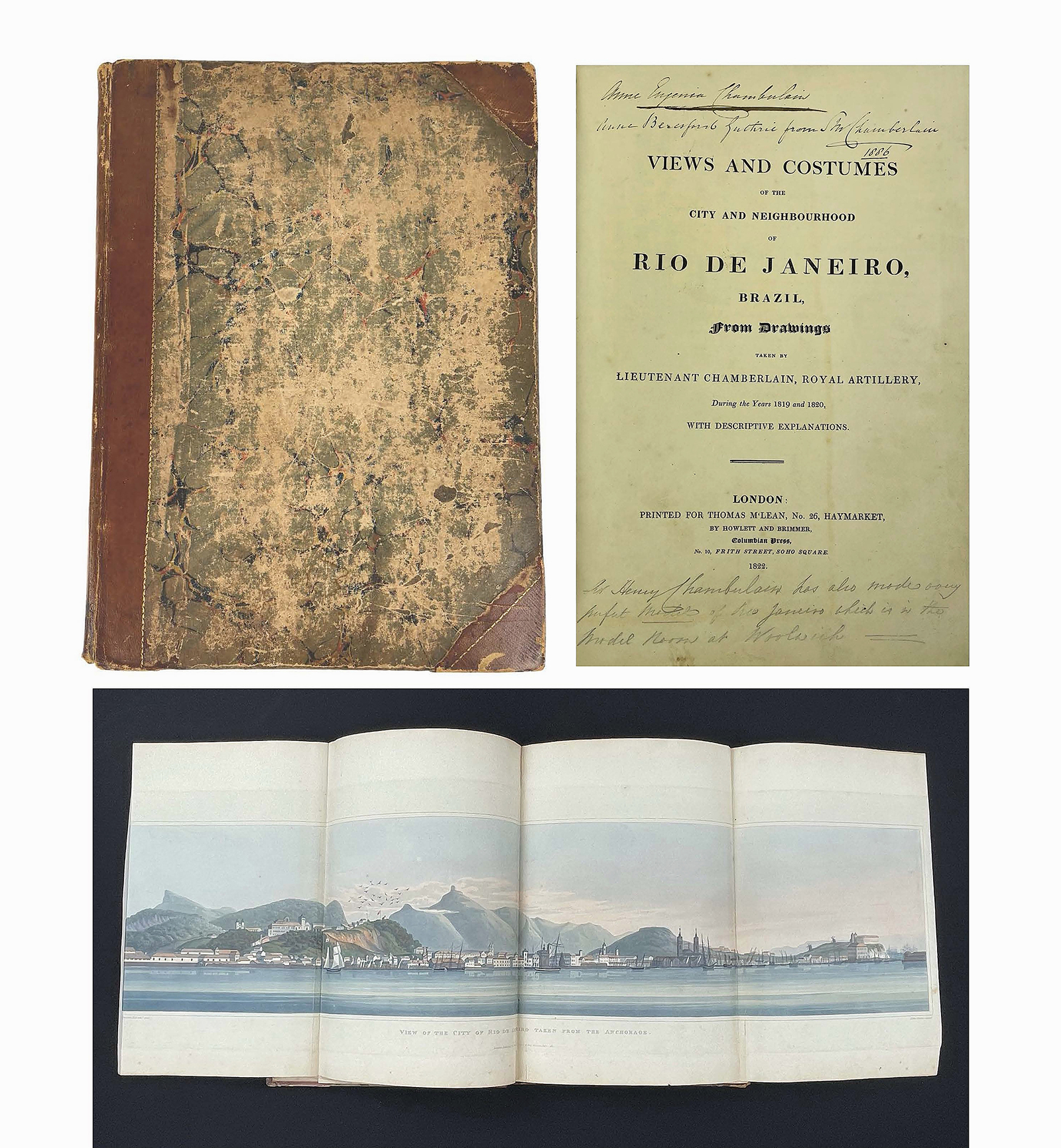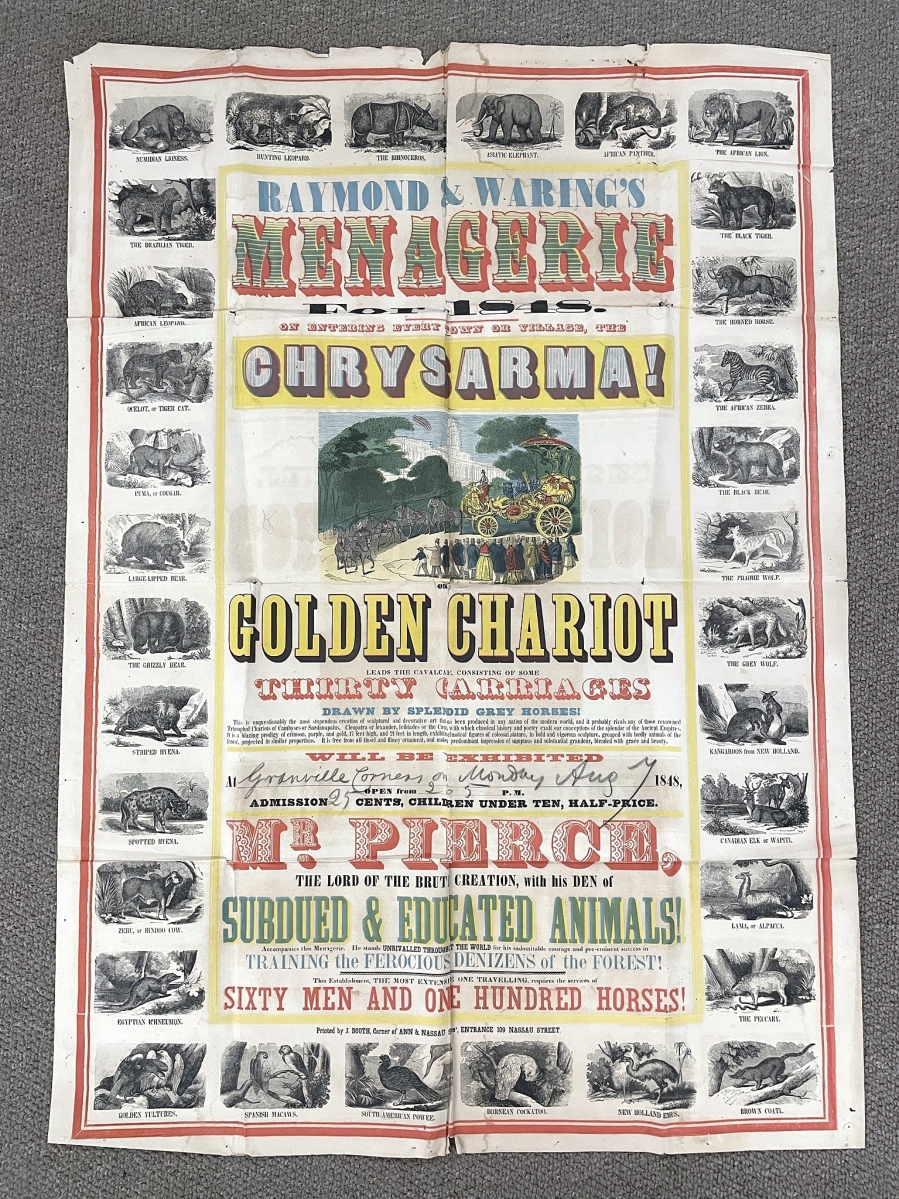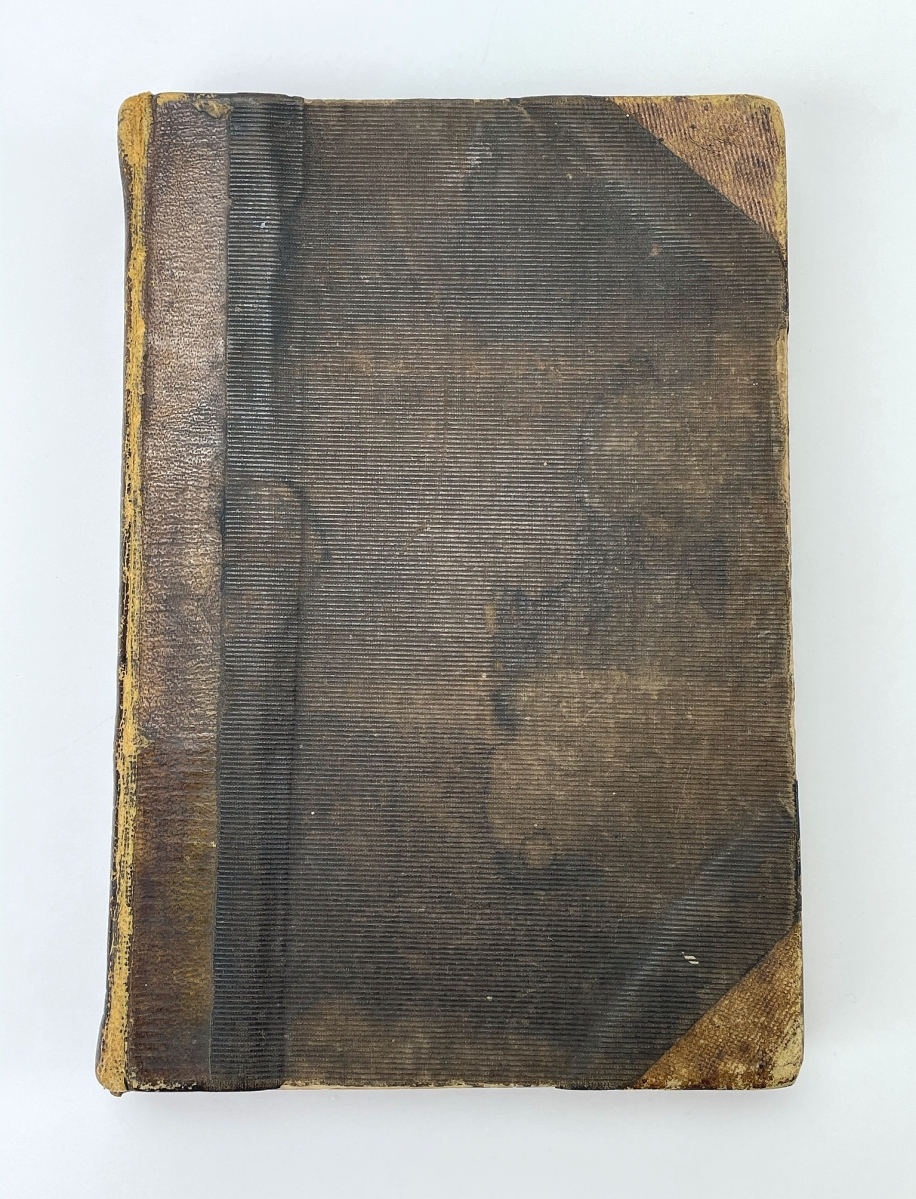
So popular were the panoramic folding plates depicting Rio’s harbor in Lt. Henry Chamberlain’s Views and Costumes of the City and Neighbourhood of Rio de Janeiro (London, 1822), that they often ended up being framed, which, coupled with the book’s issuance in parts, made finding complete copies exceedingly rare. This first edition, with notation’s by Chamberlain’s stepmother, was the top lot in the sale. Complete with all 36 plates, it sold for $108,000.
Review by W.A. Demers, Photos Courtesy Blanchard Auction Services
POTSDAM, N.Y. – The focus was on early manuscript maps, town-founding documents, business and personal papers and the library amassed by Col. Elisha Camp (1786-1866) and his wife, Sophia Hale Camp (1789-1866), of Sacket’s Harbor, N.Y., at Blanchard Auction Services’ online sale on March 28.
Following on the heels of the firm’s successful winter antiques auction, February 7-14, that presented the historic “Camp Manor” Sackets Harbor, N.Y., estate that was built for the Camps [See Antiques and The Arts Weekly Story Here], an estate that was billed as a “time capsule of American life and history from the infancy of the United States through the World Wars and into the present,” the Camp archive, comprising nearly 340 lots, was a rich cache of documents, books and ephemera shedding light on the lives of these first-generation settlers of Jefferson County, N.Y.’s most important port, as well as insight into the colonel’s roles in early US-Canadian trade and Lake Ontario steamboat and railroad promotion. And it was fresh ground – the auction house noted that while some of Col. Camp’s papers have been consulted by historians, those that were being auctioned in this sale were not.
Because most of the federal home’s contents had descended through the same family for seven generations, there was a large accretion of documents, books and papers, including presidential appointments signed by Abraham Lincoln, Andrew Johnson, Grover Cleveland, William McKinley, Theodore Roosevelt and Woodrow Wilson.

Testimony to a New York City printer’s stock of display caps, animal relief cuts and colored inks, this bright, color-printed 1848 circus poster surprised by finishing at $19,200.
Included in the Camps’ library were works on African Americans’ lives and abolitionism; early militia and US Army drill books; early medical books; published aids to international trade and commerce from 1757 to 1821; and the books with which the Camps instructed their children in all the subjects of the day, including religion, science, farming and philanthropy. In ensuing decades, the family’s bookshelves were augmented by tomes on women’s rights, Civil War manuscript letters and books and photographs, manuscripts and printed items documenting military service in Arizona and the Philippines from 1880 to 1901 and more.
The top lot in the sale spoke to the Camps’ abiding interest in travel. A rare first edition of Lt. Henry Chamberlain’s Views and Costumes of the City and Neighbourhood of Rio de Janeiro (London, 1822), complete with all 36 plates, sold for $108,000. A tour de force of folding panoramas depicting Rio’s harbor, the book included detailed depictions of enslaved African men and women working in and around specific Rio locations.
The book was Anne Eugenia Chamberlain’s copy of her stepson’s aquatint masterwork. It contained her holograph memoranda on life and acquaintances in Rio, and a note comparing the quality of these aquatints with their models, her stepson’s watercolors. The auction house noted in its cataloging that “this work is today considered as important for its exquisite aquatints of Rio’s natural topography and buildings as for the 23 of its plates that depict in equal detail enslaved Africans laboring in fields and markets, strolling, ailing, mourning their dead, rowing their ‘masters’ in harbor boats, carrying their sedan chairs and being transported in chains.”

Carefully safeguarded across seven generations of the Camp family and recently removed from the home that Elisha and Sophia Camp built in 1816/17 by their direct descendants was an important collection of early Sackets Harbor manuscripts mostly dating 1805-67. Including business, political and family papers, such as hand-drawn plot surveys, hand-drawn and colored community maps, early upstate New York railroad promoters’ correspondence and receipts for household expenditures, the lot fetched $13,200.
Royal Artillery Lt. Henry Chamberlain (1796-1843) was son of Henry Chamberlain (1773-1829), England’s consul-general and chargé d’affaires in Rio, and his first wife. The younger Henry’s father remarried after an 1813 divorce; and the second Mrs Chamberlain, née Anne Eugenia Morgan, moved with him to Rio. Young Henry traveled to Brazil in 1819 and while there painted a stunning series of documentary watercolors capturing with remarkable precision showing Rio’s topography, buildings and people. When he returned to London, he had his watercolors reproduced in aquatint and published with his letterpress commentary in six monthly parts at a guinea apiece, starting in July 1821. The book’s beauty contributed to its eventual rarity, as the panoramic folding plates depicting Rio’s harbor often ended up being framed, which, coupled with the book’s issuance in parts, have made finding complete copies exceedingly rare. It will stay in New England, having been won by a collector.
The second highest priced lot in the sale was “by far the biggest surprise,” said Sue Blanchard regarding a bright, color-printed 1848 circus poster that sold for $19,200 and is heading for Columbus, Ohio. The well-preserved, thickish wove paper elephant folio broadside promoting Raymond & Waring’s Menagerie measuring 40¾ by 28¾ inches was printed by J. Booth, Corner of Ann & Nassau Street, New York City. Intentional internal blanks completed in bold manuscript advertised the menagerie’s appearance at Granville Corners [New York or Vermont?] on Monday August 7, 1848, from 2 to 5 o’clock. The principal illustration at the poster’s center is New York’s City Hall with a crowd stylishly dressed à la mode in front. Blanchard’s noted that the huge poster is excellent testimony to the New York City’s printer’s stock of display caps, animal relief cuts and colored inks.
Fetching $13,200 was an important collection of early Sackets Harbor manuscripts mostly dating 1805-1867. They were business, political and family papers, such as hand-drawn plot surveys, hand-drawn and colored community maps, early upstate New York railroad promoters’ correspondence and receipts for household expenditures the colonel and his equally well-educated wife Sophia made. Revealed in the documents are Camp’s work as a pioneering Sacket Harbor attorney, land surveyor, shipper, steamboat and railroad promoter and lobbyist. In all, there were more than 2,000 items comprising more than 4 linear feet of papers, plus rolled commissions, diplomas and voluntary society membership certificates, two printed books on steam power and one on railroad construction. The material had recently been removed from the home that Elisha and Sophia built in 1816/17 by the Camps’ direct descendants; it had been carefully safeguarded across seven generations.

Another surprise in the sale was this manuscript 1854 collection of Shaker hymns, anthems, marches and “shuffling and quick manner songs.” Estimated $750-$1,500, it sold at $10,200.
Nor had any of Elisha Camp’s son-in-law Col. Rodney Mason’s papers (an archive measuring about 7 linear feet) been known to exist until they were rediscovered in the family’s Sackets Harbor mansion in December 2020. Mason, who made his fortune as a Detroit, Mich., patent attorney and corporate counsel specializing in food production machinery, had apparently left his legal and business papers in a trunk, covering a period of time from 1878 to the day he died in 1893. The archive realized $4,080.
Another surprise in the sale was the price achieved by a manuscript 1854 collection of Shaker hymns, anthems, marches and “shuffling and quick manner songs,” originally estimated $750-$1,500 but selling for $10,200. The songs had been collected, inscribed and signed by Charles Julius Preter (1811-1892), a native of Nassau, Germany, who immigrated to the United States in 1831, converted in 1840 and moved to Watervliet, N.Y., in 1844. In all, there were 160 pages, plus nine pages of indexes, “all very closely written in very small hand,” noted the catalog. The auction house said that it is going to a Shaker community in Maine.
A choice broadside in the sale was “Log Cabin Anecdotes / Illustrated Incidents in the Life of Gen. William Henry Harrison.” The large, two-color extensively illustrated campaign broadside promoted Whig Party nominee Gen. William Henry Harrison’s successful 1840 campaign against incumbent President Martin Van Buren, who had defeated Harrison four years earlier. Finishing at $8,280 and measuring slightly less than its framed dimensions of 25 by 19½ inches, it had 12 large relief-cut illustrations surrounding the central text, the top right one showing “Harrison saving the life of a Negro.”
Among the presidential military appointments was one signed by Abraham Lincoln, dated July 7, 1864, appointing Erskine M. Camp to assistant quartermaster. Also signed by Secretary of War Edwin McMasters Stanton., the 19-5/8-by-15¾-inch appointment printed and signed on vellum with blue US seal earned $7,920.

A choice broadside in the sale was a large, two-color extensively illustrated campaign broadside promoting Whig Party nominee Gen. William Henry Harrison’s successful 1840 campaign against incumbent President Martin Van Buren. It went out at $8,280.
Additional highlights included Audubon bird prints from the Elephant Folio, published works on Audubon and John Bachman with inserted original autograph letters written to Ruthven Deane by Audubon’s daughter and Bachman’s children, a book from the collections of both Roderick Terry and H. Bradley Martin and a third printing of Audubon and Bachman’s three-volume octavo Quadrupeds in original binding. The latter brought $5,280.
Other travel items included the 1843 London translation of Maximilian’s Travels in the Interior of North America, with numerous engravings on wood and a large map, which had been translated from the German. It was bid to $3,360. A rare item bringing $2,520 was US Navy Admiral A.S. Crowninshield’s unpublished manuscript autobiography (1843-1909), in which he detailed in his own hand his Annapolis days aboard the USS Constitution, Civil War service, cruises to (and stays in) China and Japan via Rio de Janeiro and Cape Town in 1866.
After the sale, which hosted a total of 740 registered bidders and 135 unique buyers, co-owner Kip Blanchard said, “Eighty percent of the value was in 20 percent of the stuff. We were very pleased that the Sackets Harbor stuff that had a direct link did very well.”
The firm’s next sale will take place in early May featuring a Watertown, N.Y., estate, including a Simon Willard clock and other antique timepieces. Prices given include the buyer’s premium as stated by the auction house. For more information, www.blanchardsauctionservice.com or 315-265-5070.























